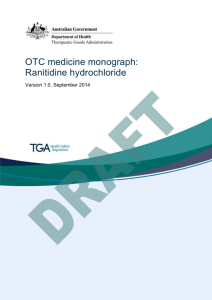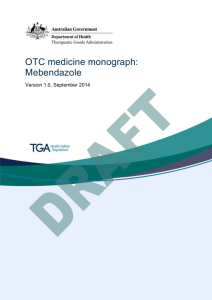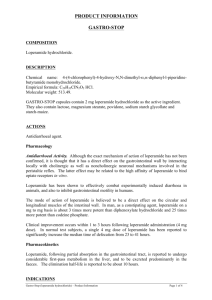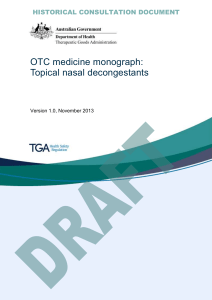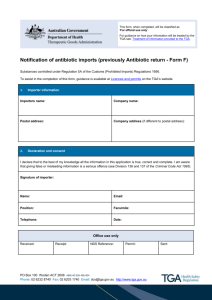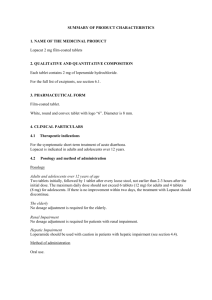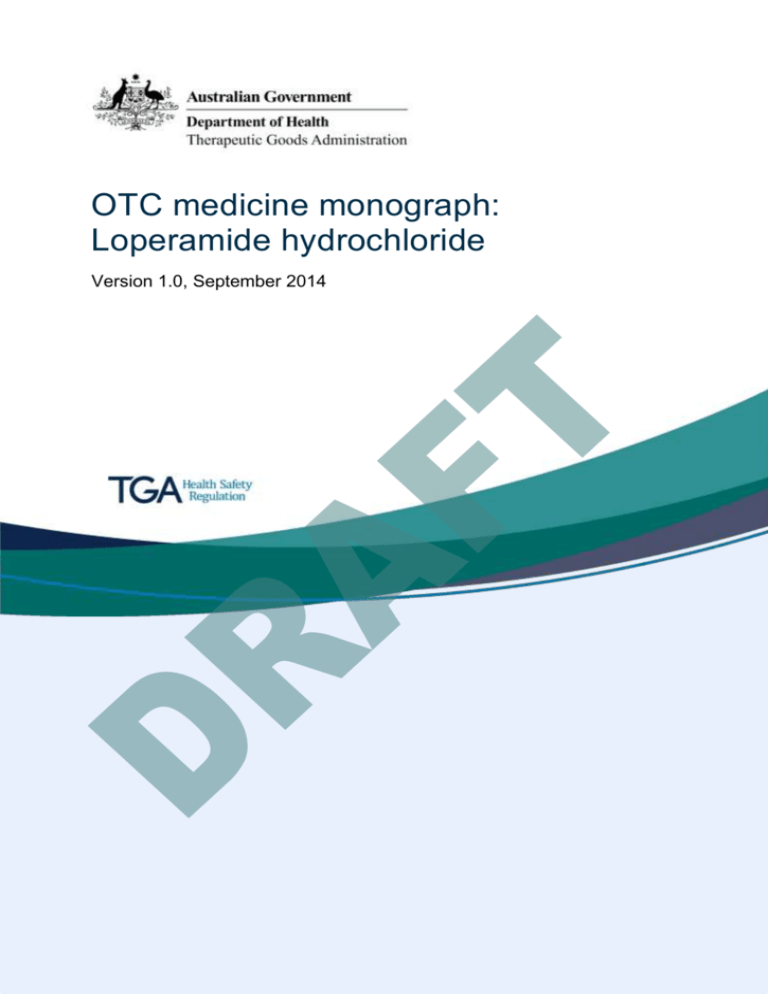
OTC medicine monograph:
Loperamide hydrochloride
Version 1.0, September 2014
Therapeutic Goods Administration
About the Therapeutic Goods Administration
(TGA)
The Therapeutic Goods Administration (TGA) is part of the Australian Government
Department of Health, and is responsible for regulating medicines and medical devices.
The TGA administers the Therapeutic Goods Act 1989 (the Act), applying a risk management
approach designed to ensure therapeutic goods supplied in Australia meet acceptable
standards of quality, safety and efficacy (performance), when necessary.
The work of the TGA is based on applying scientific and clinical expertise to decisionmaking, to ensure that the benefits to consumers outweigh any risks associated with the use
of medicines and medical devices.
The TGA relies on the public, healthcare professionals and industry to report problems with
medicines or medical devices. TGA investigates reports received by it to determine any
necessary regulatory action.
To report a problem with a medicine or medical device, please see the information on the
TGA website <http://www.tga.gov.au>.
Copyright
© Commonwealth of Australia 2014
This work is copyright. You may reproduce the whole or part of this work in unaltered form for your own personal use or, if
you are part of an organisation, for internal use within your organisation, but only if you or your organisation do not use the
reproduction for any commercial purpose and retain this copyright notice and all disclaimer notices as part of that
reproduction. Apart from rights to use as permitted by the Copyright Act 1968 or allowed by this copyright notice, all other
rights are reserved and you are not allowed to reproduce the whole or any part of this work in any way (electronic or
otherwise) without first being given specific written permission from the Commonwealth to do so. Requests and inquiries
concerning reproduction and rights are to be sent to the TGA Copyright Officer, Therapeutic Goods Administration, PO Box
100, Woden ACT 2606 or emailed to <tga.copyright@tga.gov.au>
Confidentiality
All submissions received will be placed on the TGA’s Internet site, unless marked confidential. Any confidential material
contained within your submission should be provided under a separate cover and clearly marked “IN CONFIDENCE”.
Reasons for a claim to confidentiality must be included in the space provided on the TGA submission coversheet. For
submission made by individuals, all personal details, other than your name, will be removed from your submission before it
is published on the TGA’s Internet site. In addition, a list of parties making submissions will be published. If you do not wish
to be identified with your submission you must specifically request this in the space provided on the submission coversheet.
Therapeutic Goods Administration
Version history
Version
Description of change
Author
Effective date
V1.0
Original publication
OTC Medicines
Evaluation/OMA
XX/XX/XX
OTC medicine monograph: Loperamide hydrochloride
V1.0 September 2014
Page 3 of 8
Therapeutic Goods Administration
Contents
Introduction ___________________________________ 5
Active substance _______________________________ 5
Dosage forms and strengths _____________________ 5
Indications ____________________________________ 5
Required therapeutic indications for inclusion in the Australian Register of
Therapeutic Goods _____________________________________________________________ 5
Label indications _______________________________________________________________ 5
Directions for use ______________________________ 6
Labelling ______________________________________ 6
Advisory statements ___________________________________________________________ 6
Quality requirements ___________________________ 6
Manufacture ____________________________________________________________________ 6
Finished product specifications _____________________________________________ 7
Tablets ------------------------------------------------------------------------------------------ 7
Capsules ---------------------------------------------------------------------------------------- 7
OTC medicine monograph: Loperamide hydrochloride
V1.0 September 2014
Page 4 of 8
Therapeutic Goods Administration
Introduction
This OTC Medicine Monograph outlines the requirements for Australian market authorisation of
oral medicines containing loperamide hydrochloride as a single active ingredient when applied
for as an OTC New Medicine N2 application. Proposed medicines must comply with all aspects of
the monograph relevant to their strength and dosage form to qualify for evaluation as an N2
application.
This monograph should be read in conjunction with the document Requirements for OTC new
medicine N2 applications.
Active substance
This monograph only applies to loperamide hydrochloride (CAS no. 34552-83-5) and excludes
preparations containing any other salts and derivatives of loperamide.
Dosage forms and strengths
Acceptable dosage forms and strengths are shown in the table below.
Active
substance
Dosage
strengths
Dosage forms (excludes modified
release dosage forms)
Loperamide
hydrochloride
2 mg
Hard capsules, tablets (uncoated, film
coated)
Indications
Required therapeutic indications for inclusion in the
Australian Register of Therapeutic Goods
Symptomatic treatment of acute non-specific diarrhoea. Control and symptomatic treatment of
chronic diarrhoea.
Label indications
The following label indications/claims are acceptable:
‘Diarrhoea relief’
‘Effective relief of/from diarrhoea’
‘Symptomatic relief of/from diarrhoea’
Reference to ‘loose motions’
‘Relief within 1-3 hours’
Note: Reference to ‘fast’, ‘rapid’ or similar is not acceptable.
OTC medicine monograph: Loperamide hydrochloride
V1.0 September 2014
Page 5 of 8
Therapeutic Goods Administration
Directions for use
Adults and children 12 years and over: 2 tablets/capsules initially, followed by 1 tablet after
each loose motion, to a maximum of 8 tablets/capsules per day.
Do not give to children under 12 years of age.
Labelling
Labelling must comply with all relevant Australian regulatory requirements, as detailed in the
document Requirements for OTC new medicine N2 applications, including all required warning
statements.
Advisory statements
The following advisory statements are required#:
If the condition persists after two days of treatment, seek medical advice as soon as
possible.
If you are pregnant or breastfeeding, check with your doctor or pharmacist before using this
medicine.
Drink plenty of fluids as fluid and electrolyte depletion may occur with diarrhoea. If
dehydration is suspected seek medical attention.
Do not take if you have a medical condition where constipation should be avoided.
See your doctor or pharmacist before taking [this medicine/insert name of medicine] if you
have a fever, severe stomach pain, bloody diarrhoea or ongoing condition affecting the
bowel.
# The
above advisory statements will be required by RASML Schedule 2, which is to be implemented in December 2015.
Quality requirements
In addition to the quality requirements outlined in the document Requirements for OTC new
medicine N2 applications, the following specific requirements apply to loperamide
hydrochloride monograph medicines:
Manufacture
If the total weight of the tablet or capsule exceeds 100 mg (ie. active ingredient is less than 2%
w/w of the dosage form), the manufacturing process must have been validated on a minimum of
two production batches in accordance with the requirements of GMP, prior to submission of the
application1. An assurance that this has been done must be provided with the application.
In accordance with manufacturing process validation requirements for ‘microdose’ products, as detailed in section
5.2.1 of Appendix 2 of the ARGOM
1
OTC medicine monograph: Loperamide hydrochloride
V1.0 September 2014
Page 6 of 8
Therapeutic Goods Administration
Finished product specifications
In addition to other requirements specified in the document Requirements for OTC new
medicine N2 applications, the finished product specifications must comply, at a minimum, with
the relevant set of requirements below.
The requirements below include all relevant BP general monograph/USP General Chapter
requirements and TGO78 requirements. Further reference to these is not required.
References to pharmacopoeial monographs below refer to the current monograph at time of
application.
Tablets
The tests and limits in the USP monograph Loperamide Hydrochloride Tablets with the
addition of:
tablet appearance
tighter limits for loperamide hydrochloride content of 92.5-107.5% (in accordance with
TGO 78)
Loperamide N-oxide (NMT 2% wrt loperamide hydrochloride)2
microbiological quality, in compliance with TGO 77
Capsules
The tests and limits in the BP monograph Loperamide Capsules3 with the addition of:
capsule appearance
microbiological quality, in compliance with TGO 77
Use assay method specified for Loperamide Hydrochloride Capsules BP, or an alternative equivalent or superior
method. The method must be appropriately validated as described in Requirements for OTC new medicine N2
applications.
3 Including dissolution test, with a limit of NLT 70% in 45 min, in accordance with Appendix XII B. Monographs of the
British Pharmacopoeia.
2
OTC medicine monograph: Loperamide hydrochloride
V1.0 September 2014
Page 7 of 8
Therapeutic Goods Administration
PO Box 100 Woden ACT 2606 Australia
Email: info@tga.gov.au Phone: 1800 020 653 Fax: 02 6232 8605
http://www.tga.gov.au
Reference/Publication #

